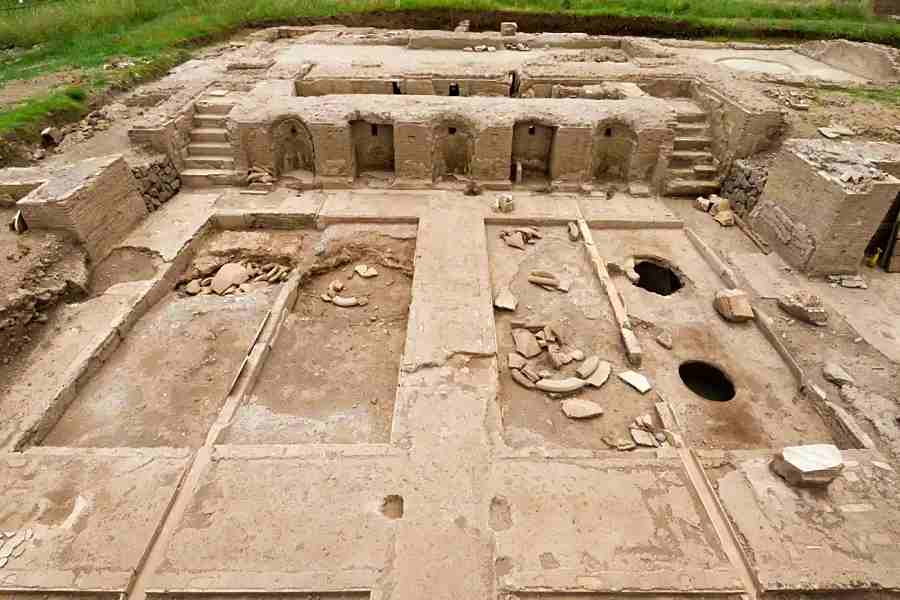Sun 23 Apr 2023:
A study published in the academic journal Antiquity, on Monday (April 17), detailed how when citizens in ancient Rome were watching gladiator duels the elite were present in the mini-city spanning 24 hectares for a very different reason, winemaking.
Villa of the Quintilii was once home to a theatre, an arena for chariot races and a bath complex with walls and floors lined in marble also had a winery where the Roman elite gathered annually for viewing the theatre of winemaking.
It is situated, south of Rome, next to the ancient Appian Way road and is also said to be the only second known example in the Graeco-Roman world of a site built specifically for this purpose.

The complex whose origins lie in the second century AD also included a series of luxurious dining rooms which had a view of fountains flowing with wine and is also just beyond the city limits possibly allowing the very elite of the Roman world like emperors.
The Villa of the Quintilii “was an amazing mini city completed by a luxury winery for the emperor himself to indulge his Bacchic tendencies,” said archaeologist Dr Emlyn Dodd who is also an expert on ancient wine production, as per the Guardian.
The villa was likely built by the Quintilii brothers who served as consuls of Rome in 151AD and were killed by Emperor Commodus around 181AD. It is also speculated that once the imperial rulers took personal ownership of the complex they had been expanding and modifying it for centuries.
The Villa of the Quintilii “was an amazing mini city completed by a luxury winery for the emperor himself to indulge his Bacchic tendencies,” said archaeologist Dr Emlyn Dodd who is also an expert on ancient wine production, as per the Guardian. pic.twitter.com/iPPhzmmFA8
— INDEPENDENT PRESS (@IpIndependent) April 23, 2023
Notably, wine and agriculture held great importance to the nobility’s wealth and power, “Wine was a huge source of wealth for the Roman elite,” Dodd told NBC News. He added, “They owned vast amounts of land dedicated to viniculture, winemaking, and they were selling it all across the Mediterranean.”
Dodd also pointed out how “wine permeates the whole culture and society — it’s used in religion, medicine, in daily life, it was the main beverage when water wasn’t safe to drink,” reported NBC News.
About the winery and the process
The winery had a purpose-built facility complete with marble-lined areas for treading grapes and fountains of wine, said a recent study. Dodd also highlighted the recently excavated areas where men would be treading grapes with their bare feet in a rectangular area measuring 37 feet by 14 feet.
He also found that the treading areas which would typically have waterproof concrete were covered in red marble. “Which isn’t ideal, as marble gets incredibly slippery when wet. But it shows that whoever built this was prioritising the extravagant nature of the winery over practical considerations,” said Dodd, as per the Guardian.
The Villa of the Quintilii “was an amazing mini city completed by a luxury winery for the emperor himself to indulge his Bacchic tendencies,” said archaeologist Dr Emlyn Dodd who is also an expert on ancient wine production, as per the Guardian. pic.twitter.com/MrWeIwsTjC
— INDEPENDENT PRESS (@IpIndependent) April 23, 2023
The study then details how the crushed grapes would be taken to the two mechanical presses, 2 metres in diameter, which stood nearby before the brightly-coloured liquid flowed into niches and created a fountain-like effect. Altogether there were five fountains, two of which produced water set into a courtyard wall.
Only one of the dining rooms has been excavated, so far, and had been lavishly decorated with marble motifs possibly to allow guests to view each stage of the winemaking process through wide entrances which were set around three sides of the open courtyard.
The grape would flow along open channels into vast ceramic dolia or storage jars placed underground which was a standard winemaking technique in ancient Rome. “It’s much more about the spectacle than the product being produced. The level of decoration, with these fountains of wine, really shows that,” said Dodd, as per NBC News.
SOURCE: INDEPENDENT PRESS AND NEWS AGENCIES
______________________________________________________________
FOLLOW INDEPENDENT PRESS:
TWITTER (CLICK HERE)
https://twitter.com/IpIndependent
FACEBOOK (CLICK HERE)
https://web.facebook.com/ipindependent
Think your friends would be interested? Share this story!





